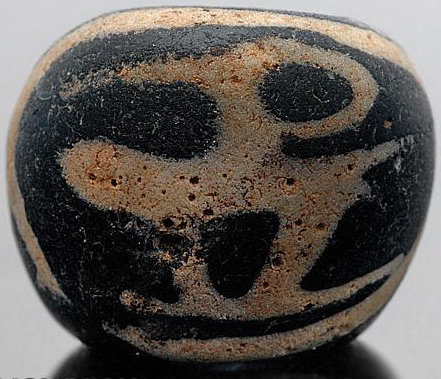| I don't think the authentic bird beads are made in the way Ornament describes | |||||
| Re: Anyone seen this before? -- tofsla | Post Reply | Edit | Forum | Where am I? | |
02/28/2013, 15:32:53
First of all, I agree of course that the bead tofsia shows is not an authentic Jatim bird/sunburst bead. It's hardly a fake, really just a modern version of a traditional pattern.
And I'm a little doubtful too about the bead on the Japanese website for reasons that I'll get to in a moment.
What really surprises me is the description from Ornament magazine that seems to me to be quite simply wrong. I'm not aware of anyone who has studied these beads closely coming to the conclusion that they were made by carving out a pattern and then filling it in with a white substance. If you look at the attached picture that just doesn't make sense.
James Lankton has described the patterns as being "trailed white glass," and in Magical Ancient Beads Jamey Allen says that these are: "blue or black spheroidal drawn beads, with trailed decoration in white glass." However, since writing that, he has come back to the topic and now, as I understand it, believes that the base blue/black beads were allowed to cool and the pattern was then applied in white enamel before being fired in a kiln to fix it to the surface.
I'm not entirely sure that I can see how this extremely unusual process led to the finished beads that have come down to us - in particular, I don't see how an enamelled pattern would become embedded in the surface of the glass to a depth of at least a millimeter - but Jamey knows much more than I do about bead technology, and for now I'll take his word for it.
What fascinates me is that this is just one more example of the technological inventiveness, the willingness to find new solutions to get the desired effects, that we find among the beadmakers who were at work in early Southeast Asia between 500 BCE and 600CE.
Now back to the "Japanese" bead. The reason I'm a bit doubtful about it is that the edges of the pattern look to be just too clearly incised into the surface of the glass. Sometimes this does happen, but in most of the beads which I've seen that I believe to be authentic there is more blurring of the edges than appears here. So it occurs to me that this particular bead may have been made in the manner that Ornament describes, not in ancient times but quite recently, with the design carved into the surface of a genuinely ancient monochrome bead and filled with a whitish paste. This was in fact a common practice among the creators of fake Jatims twenty or so years ago; they were very good at it, as genuinely inventive in their own way as their forebears.
Best,
Will

|